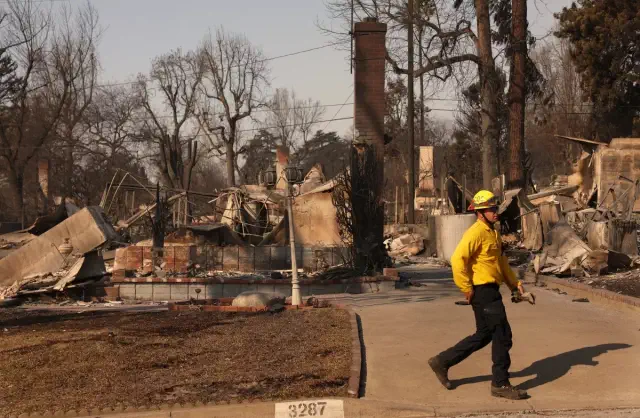
View pictures in App save up to 80% data.
Residents in fire-prone regions like Los Angeles are encountering increasing financial challenges as home insurance policies are being canceled at alarming rates. This situation underscores the pressing demand for cost-effective and creative insurance options specifically designed for high-risk areas, focusing on the protection of homeowners.
Rising expenses are placing homeowners in challenging predicaments, increasing their exposure to considerable financial risk. Conventional insurance providers frequently withdraw from these markets, resulting in a lack of choices and inadequate coverage for residents facing the threat of severe wildfires. This shortfall creates a distinct opportunity for businesses to develop creative insurance solutions that address these escalating dangers and serve regions prone to high fire hazards.
The California FAIR Plan has experienced an impressive increase in its reach, now covering more than 452,000 policies. This rapid expansion highlights a significant market need for fresh solutions to address the unique insurance challenges faced by wildfire-affected areas. New insurance startups should take note of this trend and capitalize on the opportunity to provide specialized products that extend beyond standard options. Firms that can introduce transparency and adaptability into their insurance offerings are likely to achieve a competitive advantage.
Numerous homeowners are forced to settle for insufficient coverage due to the soaring costs of insurance. This concerning trend highlights a growing need for insurance solutions that offer extensive protection without breaking the bank. As consumers become more discerning, they are on the lookout for policies that enable them to customize their coverage options while avoiding steep premiums, paving the way for creative and effective market solutions.
The increasing frequency of catastrophic events has resulted in high claim rates, adding to the complexities faced by the insurance industry and forcing companies to confront profitability issues. In California's unpredictable insurance markets, insurers need to embrace a significant transition towards advanced risk assessment tools that can more accurately gauge exposures. By incorporating cutting-edge technology into the underwriting process, insurers can enhance their ability to forecast and manage risks, allowing for more precise and sustainable pricing of their products.
California homeowners are increasingly advocating for greater transparency in the insurance industry. Many are eager to comprehend the specifics of their policies but find themselves overwhelmed by the intricate language and obscure clauses typical in conventional contracts. There is a heightened demand for straightforward terms and conditions, as homeowners seek more accessible and comprehensible explanations of their policies.
As consumers maneuver through the complex world of insurance, engaging stakeholders and providing education will be essential. Both new startups and well-established insurance companies need to focus on consumer education programs that assist residents in areas at high risk for fires in understanding their insurance choices. This approach not only empowers homeowners to make knowledgeable decisions but also cultivates stronger trust and loyalty between insurers and their customers.
Current developments suggest a movement towards group insurance frameworks that may offer cost-effective coverage solutions for homeowners in vulnerable areas. Such models enable residents to combine their resources and collectively manage risks, leading to reduced premiums and greater flexibility in coverage options. By investigating innovative insurance structures, new startups have the opportunity to attract a market segment that has often been overlooked by conventional insurance providers.
Moreover, the ongoing trends in climate change are leading to a rise in wildfires throughout the state, presenting new obstacles for both insurers and homeowners. This ongoing situation underscores the escalating demand for creative and efficient insurance solutions. Stakeholders in the insurance sector must take proactive measures to address these shifts by focusing on the creation of adaptive risk management strategies.
By embracing innovative approaches, insurance firms have the potential to revolutionize their interactions with homeowners in high-risk areas. This could involve leveraging AI to create predictive loss models that consider localized environmental variables, making sure that premiums accurately reflect unique risks. Through the use of advanced technology, insurers can enhance their support for communities that frequently feel overlooked and vulnerable.
To tackle the specific difficulties encountered by homeowners in regions susceptible to wildfires, insurance startups have the opportunity to spearhead a transformation in coverage solutions. By diversifying their product lines and enhancing transparency, these companies can foster enduring connections with clients while appealing to a growing population that is increasingly concerned about their safety. Forward-thinking firms that grasp the intricate risks associated with these areas will cultivate a dedicated clientele eager to back their objectives.
As the insurance industry transforms, astute homeowners are increasingly seeking alternatives to conventional providers, favoring more comprehensive and customer-focused options. Insurers that tailor their products and services to address the urgent needs of individuals living in wildfire-affected regions stand to gain significantly over time. The moment for innovation is upon us, and those prepared to take bold steps will not only establish themselves as frontrunners in the market but also deliver valuable solutions to homeowners in distress.